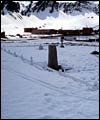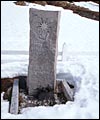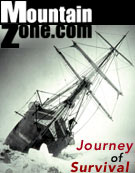In the Footsteps of Sir Ernest Shackleton
Shackleton's Antarctic journey of survival is eclipsed by his trip from oblivion to pop-culture phenomenon
Seattle- August 20, 2002
Pages: 1 2 3 4 5 6
Photos Grytviken graveyard |
|
If the Nova film brings intelligent commentary and insightful context to the incredible saga of Endurance, the film may in fact mark both the high point and the beginning of the end to the current fascination with Shackleton. Shackleton mania is, apparently, a cyclical phenomenon: it first occurred upon Shackleton's safe return to England during World War I. Every few decades, it seems, as new biographies of Shackleton or accounts of the Endurance adventure are published, the explorer's fame bubbles over once again into the mainstream to inspire a new generation. The phenomenon occurred in the 1950s with Lansing's account, and was re-ignited in 1998 with Alexander's best-selling book. Presumably, the current wave of fascination with the man and his incredible achievement is near its peak; as it wanes, as it always does, Shackleton once again will recede in the popular consciousness.
"Among the dozen or so gravestones is one that's higher and more ornate than the others. The upright granite block marks the site of Shackleton's grave...." |
I was alone among the abandoned buildings. The spring snow was still hip deep in places, so I stepped back in to my bindings and skied out past the church in which Shackleton's funeral was held, and out past the former dormitories and the rusting remains of the whaling factory. From there, I could see my destination: a small plot surrounded by a white fence on the far side of the settlement. This is the local cemetery, the place where those whalers unfortunate enough to die so far from home were put to rest.
Among the dozen or so gravestones is one that's higher and more ornate than the others. The upright granite block marks the site of Shackleton's grave. I skied closer, and on examination found engraved onto the polished stone these words:
"I hold that a man should strive to the uttermost for his life's set prize."
The lines are from Robert Browning, who was a favorite of Shackleton's, and they seem appropriately spare yet reflective of the drive that Shackleton brought to his explorations.
Photos Shackleton's Grave |
|
I never met the man, but I've read what I could, and researched far-flung archives, and even walked a mile in his shoes. I admire Shackleton for this: his nerves of high-carbon steel, and his ability, when the worst happened, to see beyond the panic to what might be done to save the day. Those of us in these modern times could learn a thing or two from that.
So I for one won't be sorry to see Shackleton move out of harsh glare of the current limelight. I know he'll be back again. And if during the next few years his memory does slip from mainstream consciousness, he won't be gone for good, he'll merely resume his place as an enduring icon of the spirit of adventure.
— Peter Potterfield, MountainZone.com Staff

